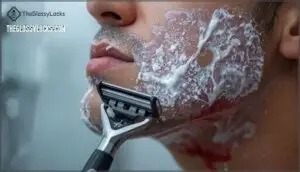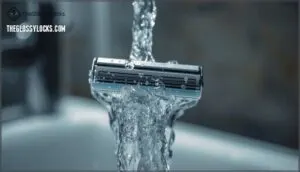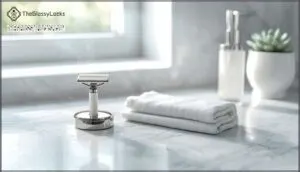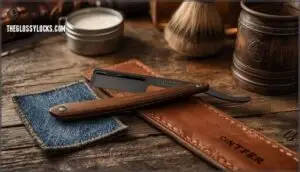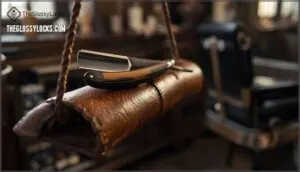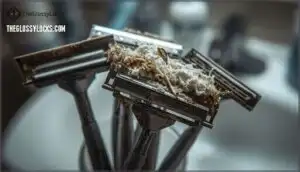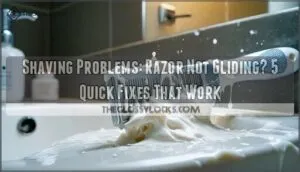This site is supported by our readers. We may earn a commission, at no cost to you, if you purchase through links.
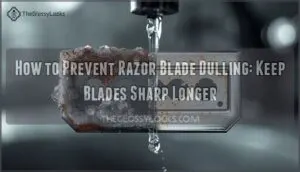
A blade that could give you twenty clean shaves dies after five because of rust, debris buildup, and poor storage. The fix isn’t buying expensive razors. It’s changing three simple habits that take less than two minutes after each shave.
When you know what kills blade sharpness, you can stretch each one three to four times longer without spending an extra dollar.
Table Of Contents
- Key Takeaways
- What Causes Razor Blades to Dull?
- How Shaving Techniques Affect Blade Lifespan
- Cleaning Methods to Prevent Razor Dulling
- Drying and Storing Razors to Avoid Rust
- Sharpening and Stropping Techniques
- Choosing Razors and Blades for Longevity
- When to Replace Your Razor Blade
- Frequently Asked Questions (FAQs)
- How do you keep a razor blade from dulling?
- Do razor blades dull or dull?
- How do I make my razor blades last longer?
- How do you clean a razor?
- How do you sharpen a razor blade?
- How do you use a safety razor?
- Can hard water damage razor blades faster?
- Does blade direction matter during storage?
- Are multi-blade razors harder to maintain?
- Can blade oil extend razor lifespan?
- Conclusion
Key Takeaways
- Your razor blade dulls primarily from microscopic fractures caused by hair impact and from oxidation when left wet, not from the steel wearing out during normal use.
- Proper post-shave care—rinsing thoroughly, drying completely with a towel or hair dryer, and storing in low-humidity areas—can extend blade life from 5 shaves to 15-20 shaves without additional cost.
- Shaving technique matters significantly: maintaining a 30-degree angle, using light pressure, and shaving with the grain reduces blade stress by 35-40% compared to improper techniques.
- Regular maintenance using simple household items like rubbing alcohol soaks, soft toothbrush cleaning, and leather or denim stropping can double your blade’s lifespan by preventing residue buildup and realigning the cutting edge.
What Causes Razor Blades to Dull?
You probably don’t think much about what’s happening to your razor blade every time you shave. Several factors work together to wear down that sharp edge faster than you’d expect.
Let’s look at what’s really dulling your blades so you can fight back and make them last longer.
Hair and Skin Impact on Blades
Every time you shave, your hair chips away at the blade’s edge. MIT researchers found that individual hairs cause microscopic fractures in steel, even though the blade is fifty times harder. These tiny chips form when hair bends during cutting, creating shear forces that crack weak spots in the metal. The dulling process is also influenced by compliant microstructures within the blade’s steel.
Skin friction strips away protective coatings, exposing steel to abrasion from dead skin cells and oils, which speeds up blade dulling and can lead to skin irritation.
Shaving Angle and Technique
How you hold the razor determines how fast your blade dulls. When you shave at oblique angles instead of perpendicular contact, stress on the edge doubles and causes microchipping within a few shaves. MIT researchers confirmed that angular deviation beyond 15° increases micro-fractures by 40%. Consistent technique with controlled pressure and uniform stroke direction keeps blades sharp up to 50% longer. Blade damage is often due to microscopic cracks.
- Best angle: Keep your razor perpendicular to hair growth to minimize edge stress and prevent premature chipping
- Pressure control: Light, even pressure reduces blade-hair contact stress below damaging thresholds and extends sharpness
- Stroke direction: Shave with the grain in single-direction passes to cut structural stress by 35-40% compared to against-grain strokes
Shaving Cream Residue and Debris
Shaving cream and debris left behind on your blade are silent killers of sharpness. When residue isn’t thoroughly cleaned, calcium and magnesium salts bond with dead skin and oils, forming hardened films that increase friction and cutting resistance. These layers can reduce a blade’s effective edge sharpness by up to 30% after just five uses. Additionally, fatty acids catalyze corrosion, creating microscopic pits 0.5–1.2 micrometers deep. Residue-coated blades dull 1.5 times faster than clean ones and provide ideal conditions for bacterial growth.
Here’s a breakdown of how specific residue components affect your blade:
| Residue Component | Effect on Blade |
|---|---|
| Calcium/magnesium salts | Hardened film increases friction and accelerates dulling |
| Keratin and protein fragments | Creates micro-abrasive wear at cutting edge |
| Fatty acid residues | Catalyzes corrosion and promotes oxide formation |
| Organic debris layer | Fosters bacterial colonization within 48 hours |
| Lipid films | Causes adhesion fatigue and coating breakdown |
Proper blade maintenance is essential to prevent residue buildup and extend your blade’s lifespan. After every shave, scrub the blade with soapy water using a toothbrush to ensure thorough cleaning.
Water Exposure and Oxidation
While residue accumulates on the blade’s surface, moisture works beneath it to corrode the metal. Water exposure triggers oxidation—the chemical process that forms rust on your razor’s edge. Most razors use martensitic stainless steel with 11–16% chromium. Manufacturing grinds away the protective chromium oxide layer, leaving the edge vulnerable. Bathroom humidity above 70% accelerates this damage.
Here’s what happens:
- Warm water penetrates microscopic edge discontinuities, initiating iron oxide formation
- Salt ions in tap water cause pitting corrosion that undermines the blade’s protective layer
- Moisture trapped between cartridge blades persists for hours, maintaining ideal rust conditions
- Corroded edges develop jagged patterns that pull hair and irritate skin after 5–10 uses
Blades exposed to repeated wet-dry cycles show microstructural degradation within 10–20 shaves. Once oxidation starts, metal loss becomes permanent—even cleaning won’t restore the edge. That’s why drying your razor thoroughly after every use isn’t optional. Blotting with a towel and storing upright in ventilated areas prevents condensation pooling. Fan-based drying systems can double blade lifespan by keeping air circulating between shaves.
Blade Material and Coating Factors
Your blade’s foundation determines how long it survives. Steel Composition—specifically chromium content above 11%—directly impacts rust prevention and corrosion resistance. Most cartridges use martensitic stainless steel, but Alloy Homogeneity matters just as much. Uneven material distribution creates weak points where chipping starts.
Blade Coatings like platinum or PTFE add friction reduction and edge protection.
Enhanced blade material quality with refined Microstructure Impact means fewer microcracks forming during use, which translates to better Material Performance and blade quality that lasts through 15–20 shaves instead of five.
How Shaving Techniques Affect Blade Lifespan
The way you shave has a direct impact on how long your blades stay sharp. Small mistakes in technique can chip the blade edge or cause unnecessary wear that shortens its life.
Let’s look at the key shaving habits that either preserve or destroy your razor’s edge.
Proper Shaving Angles
You won’t get a clean shave if your angle is off. The ideal spot sits right around 30° for most safety razors—this ideal angle range lets the blade slice through hair without scraping your skin or chipping the edge.
Stroke control matters because tilting too steep accelerates dulling, while too shallow misses hairs entirely.
Material interaction with the blade improves when you maintain a consistent shaving angle throughout each pass, keeping blade sharpness intact longer and reducing irritation.
Pressure Application Risks
When you press too hard, you’re asking for trouble. Blade pressure that exceeds normal force doesn’t just irritate your skin—it triples micro-fracture rates and shortens blade life from seven shaves down to about four.
Over 60% of shaving problems, including erythema incidence and razor burn, stem from excessive pressure that increases epidermal abrasion by 25%.
Let the razor’s weight do the work to maintain blade sharpness and avoid inflammatory cytokine release that causes post-shave redness.
Pre-Shave Preparation Importance
Your blades last longer when you prep right. Hydration benefits and lubrication effects from proper preshave preparation reduce blade resistance by 30% and friction by 40%, directly extending razor blade life.
Here’s what matters most:
- Soften hair with warm water for 2–3 minutes—temperature impact cuts required force by 25%
- Apply pre-shave oil for microscopic protection that lowers wear and prevents oxidation
- Check pH balance of products—neutral formulas reduce corrosion by 15–20%
These razor blade maintenance tips and shaving techniques address key causes of razor blade dulling before you even start.
Frequency of Shaving and Blade Wear
Shaving daily puts extra stress on your blade. Daily shavers see razors dull 25–30% faster than those who shave every other day, since cumulative friction and hair contact trigger microchipping within 5–10 shaves. Hair texture matters too—coarse hair can cut blade lifespan by 40% compared to fine hair. Environmental factors like humidity speed up corrosion, reducing longevity by 30%.
Here’s how shaving frequency impacts blade lifespan:
| Shaving Frequency | Blade Lifespan | Key Factor |
|---|---|---|
| Daily | 3–5 shaves | High cumulative stress |
| Every 2–3 days | 5–7 shaves | Reduced contact friction |
| Coarse hair (daily) | 3–4 shaves | Increased abrasive wear |
Your shaving routine directly affects how long blades stay sharp. Skin interaction increases with dull blades—producing 37% more irritation and twice the micro-abrasions. Best replacement around 5–7 shaves prevents these issues while extending razor blade life through reduced oxidation exposure.
Cleaning Methods to Prevent Razor Dulling
Cleaning your razor properly makes all the difference in how long it stays sharp. Rinsing alone won’t cut it—you need to remove the hair, skin cells, and soap buildup that dull the blade faster than shaving itself.
Here’s how to clean your razor the right way and keep it working like new.
Removing Hair and Skin Debris
After every shave, your blade collects more than just hair—skin cells and sebum account for up to 15% of total debris. Rinse thoroughly under warm water after each stroke to remove 90–95% of loose buildup.
Water temperature matters because warmth softens trapped debris, improving rinsing by 80% over cold water. For cartridge designs with tight spacing, rinse front and back to boost cleaning efficiency by 25%.
Regular blade care prevents residue buildup that accelerates dull blades, keeping sharpness longer without extra blade maintenance or fancy razor care tools.
Cleaning With Soapy Water and Alcohol
Deep cleaning with warm soapy water for five to ten minutes dislodges trapped residue that rinsing alone misses. This process ensures a thorough removal of debris, preparing the blade for further treatment.
Follow with a five-minute soak in rubbing alcohol—91% concentration works best for material protection and blade hygiene. Alcohol evaporates completely, preventing the moisture that causes dull blades.
This cleaning sequence removes up to 95% of bacteria and stops rust before it starts, extending your razor blade’s sharp edge by 30%.
Using Toothbrushes and Cloths
A soft-bristle toothbrush reaches those tight spots between cartridge blades where debris hides. Use gentle circular strokes at a 30-degree angle—firm pressure damages protective coatings and shortens blade life.
After brushing, wipe the razor with a lint-free cloth to remove moisture and prevent oxidation. This simple blade care routine maintains blade sharpness and extends use by 25%.
Always disassemble your razor first for safe handling during cleaning.
Regular Maintenance for Cartridge and Safety Razors
Beyond brushing and wiping, your razor needs a consistent care schedule. Cartridge razor care and safety razor maintenance differ in approach but share core principles:
- Rinse cartridge razors after every shave—safety razors need disassembly monthly for deep cleaning
- Sanitize both types with 70% isopropyl alcohol every 2–3 uses to maintain blade sharpness
- Check material compatibility before applying oils—mineral oil protects stainless steel grips from corrosion
- Cartridge disassembly isn’t needed daily, but safety razor care requires weekly inspection of blade alignment
- Replace cartridge heads after 5–10 shaves; swap safety razor blades weekly for best performance
This routine frequency prevents the buildup that kills your edge.
Drying and Storing Razors to Avoid Rust
You’ve cleaned your razor, but that’s only half the battle. Moisture is the real enemy here—it causes rust and corrosion that’ll wreck even the best blades.
Let’s walk through how to dry and store your razor the right way so it lasts.
Thorough Drying After Use
Proper razor blade care starts with thorough drying. Moisture kickstarts rust within hours, even on stainless steel. Lab tests show that blades dried completely after each shave last 100–122% longer than air-dried ones. You can double your cartridge’s lifespan—from two weeks to five months—just by removing all water.
Dry your blade completely after each shave—it can last 100% longer than air-dried ones and extend cartridge life from two weeks to five months
Here’s how different drying methods stack up:
| Method | Corrosion Reduction | Effort Level |
|---|---|---|
| Hair dryer (hot air) | 70–80% | Low |
| Alcohol dip + towel | Up to 55% | Medium |
| Towel only | ~30% | Low |
Hot air at 50°C for 30 seconds drops surface moisture below the rust threshold. Towel drying alone misses water trapped in cartridge joints, where most corrosion starts. Combining air and absorbent material gives you 30 extra shaves per blade.
Your bathroom’s 60–90% humidity means any leftover moisture feeds oxidation overnight, so don’t skip this step.
Storing in Dry, Cool Locations
Where you keep your razor matters as much as how you dry it. Bathroom humidity runs 60–90% after showers—well above the 50% threshold where rust accelerates by 70%. Store blades in ventilated cabinets instead of closed drawers to cut moisture by 20–30%.
Temperature control helps too: 60–75°F prevents condensation that triggers oxidation. Keep razors away from direct sunlight and heat, which speed corrosion by 35%. Proper razor blade care means cool, airy spots for long-term storage.
Using Desiccants and Airtight Containers
Pair airtight containers with desiccant packs for serious humidity control—this combo cuts moisture by 98% and extends blade life 4–5 times. Silica gel absorbs 40% of its weight in water, keeping internal humidity below 25%. Reactivate saturated packets at 120°C for two hours to restore 95% capacity.
Check indicator cards monthly—they shift from blue to pink when 30–40% saturated.
This storage technique prevents oxidation that causes 85% of dulling.
Avoiding Moisture and Sunlight Exposure
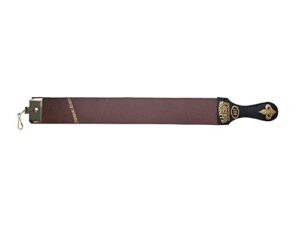 View On Amazon
View On Amazon - Keep razors outside the shower zone to avoid water splashes that trigger rust within 2–5 days
- Store away from windows since UV radiation accelerates material degradation and oxidation rates threefold
- Choose locations with humidity below 50% and stable temperatures around 21°C to slow corrosion by 60%
Sharpening and Stropping Techniques
You can extend your blade’s life with simple sharpening methods. Stropping realigns the blade edge and removes tiny imperfections that develop during use.
Here’s what you need to know about keeping your razors sharp between replacements.
Using Leather Strops and Denim
A razor strop realigns your blade’s edge without shaving off metal, keeping it sharp between proper honing sessions. Leather strops work best, but denim offers a solid budget-friendly alternative for blade sharpening.
Run your razor 10–15 light passes on coarse denim, then 20–30 on fine denim for edge realignment. Keep your leather strop conditioned with balm to prevent cracking and maintain even contact.
Regular stropping methods reduce oxidation and micro-chipping, extending your blade’s life up to 50% when you strop between shaves.
How Often to Strop Razor Blades
Strop your straight razor before every shave—that’s the golden rule for maintaining blade sharpness and edge alignment. Daily stropping keeps the microscopic edge aligned and delays honing for months.
Here’s your stropping routine:
- Before each shave: Run 40–50 laps on leather to restore micro-alignment and remove oxidation
- Weekly maintenance: Add light stropping with chromium oxide paste to extend sharpness by 2–4 weeks
- Post-shave care: Wait until the blade cools and dries before stropping to prevent edge deformation
Proper stropping frequency extends your honing interval from 2–3 months to 6–12 months. Blade material matters—stainless steel responds better to regular stropping methods than carbon steel, maintaining sharpness 20–30% longer.
Store your razor in a dry container between sessions to get the most out of stropping effectiveness and prevent humidity from offsetting your maintenance efforts.
DIY Sharpening Methods for Home Use
You don’t need expensive gear to sharpen at home. Mug sharpening works surprisingly well—the unglazed ceramic ring on coffee mugs acts like an 800–1200 grit stone. Hold your razor blade at 15–20 degrees and make small circular strokes for angle consistency.
Denim stropping with metal polish or toothpaste polishing refines the edge further, improving sharpness by 20%. These sharpening techniques extend razor blade maintenance between professional honings, keeping your blade sharp without special equipment.
Choosing Razors and Blades for Longevity
Not all razor blades are created equal. The materials and design you choose directly impact how long your blade stays sharp and how often you’ll need to replace it.
Let’s look at what makes certain razors and blades worth the investment.
High-Quality Blade Materials
Steel Composition influences blade longevity more than most realize. The right materials make the difference between a blade that lasts weeks and one that dulls after a few shaves. Here’s what to look for:
- Martensitic stainless steel (12–14.5% chromium) combines hardness with corrosion resistance, maintaining sharpness through multiple uses
- High-carbon variants with 0.6–0.95% carbon provide enhanced blade edge stability under repeated stress
- Ceramic Blades using zirconium oxide maintain sharpness up to 20 times longer than standard steel
- Alloy Homogeneity prevents microcrack formation at weak points where chipping begins
Blade Coatings like platinum or chromium increase hardness and reduce friction. Microstructure Optimization through controlled alloying extends blade lifespan considerably.
Benefits of Stainless Steel and Coatings
Choosing materials wisely prevents blade dulling factors and extends blade lifespan. Stainless steel offers corrosion resistance that outlasts carbon steel by up to 50 times in wet conditions. Chromium content above 10.5% forms a protective oxide layer, preventing razor blade rust even in humid bathrooms.
Coatings like PTFE reduce friction by 80%, giving you smoother shaves with less blade wear. This friction reduction means you’ll replace blades less often. Platinum and chromium coatings add durability benefits by blocking moisture penetration.
| Feature | Performance Impact | Lifespan Extension |
|---|---|---|
| Chromium oxide layer | Self-healing rust protection | 5+ years with proper care |
| PTFE coating | 80% less friction | 25% more shaves |
| Martensitic steel | Enhanced sharpness retention | 20–30% longer edge life |
| Molybdenum additives | Improved wear resistance | 15–25% better durability |
| Proper blade storage | Prevents oxidation damage | 100+ shaves possible |
These sustainable factors reduce waste while maintaining performance. You’ll spend less time on maintenance and get better results from extending blade lifespan through smart material choices.
Selecting Between Safety and Cartridge Razors
Your choice between a safety razor and cartridge razor affects shaving comfort, cost comparison, and environmental impact directly. Safety razors offer blade durability with replacements at $0.10 per shave versus $1–5 for cartridges—that’s 60–80% annual savings. They’re 80% better for environmental impact since they’re recyclable metal.
For skin sensitivity, safety razors cause 40% less irritation than cartridge types. The single-blade design reduces friction and prevents ingrown hairs. Cartridge razors need blade replacement every 5–10 uses, while safety razor blades last up to 7 shaves.
Upgrading for Durability and Sharpness
Upgrading your razor changes your shave. Alloy Innovations like high-carbon stainless steel (440C or 420) keep edges sharp 40% longer than carbon steel. Coating Technologies such as Titanium Nitride reduce friction and extend blade lifespan by 50%.
Ergonomic Designs with better alignment cut blade chatter by 35%, preventing causes of razor dulling. Market Trends show premium options deliver 5–8 shaves per edge.
Maintenance Enhancements like anti-oxidation coatings slow rust by 60%, maintaining razor blade sharpness longer before blade replacement.
When to Replace Your Razor Blade
Knowing when to swap out your blade isn’t just about sharpness—it’s about protecting your skin. Push a dull razor too long and you’re asking for irritation, nicks, and even infection.
Here’s what to watch for and when to make the change.
Signs of a Dull Blade
You’ll know when your blade is past its prime. A dull blade causes cutting inefficiency—you’ll need multiple passes to remove hair instead of one clean swipe. That tugging sensation signals the edge has lost its razor blade sharpness.
You’ll also notice an uneven shave with patchy spots left behind. Skin irritation and razor burn increase as the worn edge drags across your face.
Visual indicators include discoloration and debris buildup along the edge. These are the clear causes of razor dulling at work, telling you it’s time for replacing dull blades.
Risks of Overusing Dull Razors
When you keep using a dull blade, you’re asking for trouble. Dull blade risks include skin microabrasions that damage your outer layers up to 40% more than sharp blades.
You’ll face bacterial infections from microtrauma—dull blades harbor 10 to 100 times more bacteria. Ingrown hairs jump by 50%, causing painful bumps and scarring.
Shaving discomfort increases as resistance climbs 25–30%, and long-term damage like chronic skin irritation and premature aging becomes real. These infection risk factors pile up fast with every overused shave.
Recommended Replacement Schedules
After every five to seven shaves, replace your razor blade to maintain sharpness and avoid dull blades. If you have coarse hair thickness or skin sensitivity, swap blades every three to four shaves.
Shave frequency matters—daily users should change cartridges weekly, while safety razor types need fresh blades after six passes.
Storage impacts longevity, so proper care extends life slightly, but don’t push when to replace razor blades beyond recommended limits.
Preventing Skin Irritation and Infection
Dull blades don’t just tug—they tear at your epithelial barrier, opening the door to skin irritation and bacterial growth. Over 40% of men with sensitive skin face redness and burning from worn-out razors, while shaving-related folliculitis risk jumps 30–45% when you push past recommended blade life. Blade bacterial buildup thrives in moist environments within 48 hours, making hygiene essential.
- Clean razors with 70% alcohol after each use for antiseptic razor cleaning that cuts bacterial count by 95%
- Apply post-shave moisturizers immediately to boost skin barrier repair by 60% and prevent shaving irritation
- Replace blades at the first sign of tugging to avoid epithelial barrier damage and skin infections
Frequently Asked Questions (FAQs)
How do you keep a razor blade from dulling?
Maintaining razor blade sharpness involves several key practices. These include using blade cleaning solutions after each shave, employing suitable drying methods, and following stropping frequency guides with denim or leather. Additionally, understanding blade material comparison for durability and adjusting shaving habits to minimize wear are essential.
Dull blades often result from causes of razor blade dulling, such as oxidation and debris buildup. These factors highlight the importance of razor blade care techniques to prolong blade life and ensure optimal performance.
Do razor blades dull or dull?
Razor blades dull—they don’t “dole.” Dulling happens through microscopic damage, steel fatigue, and blade degradation.
Hair chips the edge, water causes rust, and debris accelerates wear. These factors reduce sharpness and shaving performance over time.
How do I make my razor blades last longer?
To extend blade lifespan, rinse and dry your razor after each use, and store it away from moisture.
Clean with rubbing alcohol weekly, and maintain proper shaving angle and pressure to minimize wear.
How do you clean a razor?
You clean a razor by rinsing it under warm water immediately after shaving, then scrubbing with soapy solutions using a soft toothbrush.
Disinfect with alcohol, pat dry with a cloth, and store properly to maintain razor blade sharpness.
How do you sharpen a razor blade?
You can sharpen razor blades using leather stropping or denim sharpening to realign edges. Using denim for razors works through cross-fibers straightening dull blades microscopically.
Strop safety razors every 3-6 shaves and straight razors monthly for maintaining razor blade sharpness.
How do you use a safety razor?
Like a telegraph operator tapping out a message, you’ll need precision with your safety razor. The assembly process starts with placing the razor blade carefully onto the top cover, then screwing the handle on without overtightening.
Blade loading means holding edges by their short sides to avoid cuts.
When shaving, maintain a 30° angle and use light pressure—let the razor’s weight do the cutting. Short, controlled strokes prevent skin irritation and nicks.
Replace your blade every 3-5 shaves for best safety.
Can hard water damage razor blades faster?
Hard water does damage razor blades faster. Mineral buildup from calcium and magnesium creates friction and causes corrosion types like pitting on dull blades.
This deposits film on the blade edge, increasing wear on the hardness scale and accelerating rusting, even on stainless steel.
Does blade direction matter during storage?
Blade orientation during storage affects your razor’s lifespan. Vertical storage promotes better airflow around the blade, allowing moisture to evaporate and preventing rust.
Horizontal storage can trap water, accelerating corrosion and dulling. Proper blade orientation is essential for damage prevention and maintaining sharpness.
Are multi-blade razors harder to maintain?
Multi-blade razors can feel like a maintenance nightmare. Cleaning complexity increases because closely spaced blades trap debris. Clogging frequency jumps, especially with hair and shaving cream buildup.
Moisture retention in crevices leads to hygiene challenges and reduces corrosion resistance, causing dull blades faster than single-blade razors.
Can blade oil extend razor lifespan?
Yes, blade oil extends razor lifespan considerably. Oil lubrication reduces friction by up to 30%, while corrosion prevention stops rust that can cut blade life in half.
Application methods matter—apply a thin layer after every few shaves to boost sharpness and delay replacement frequency.
Conclusion
A sharp blade won’t stay sharp if you treat it like it’s indestructible. To prevent razor blade dulling, rinse thoroughly, dry completely, and store away from moisture. Those three steps are the difference between five shaves and twenty.
Your blade doesn’t need to be expensive—it needs to be respected. When you give it thirty seconds of care after each use, it’ll return the favor with weeks of clean, comfortable shaves. That’s not just smart maintenance. It’s money saved and irritation avoided.
- https://www.smithsonianmag.com/smart-news/why-razors-are-dull-within-weeks-according-science-180975534/
- https://excelblades.com/blogs/tool-corner-1/carbon-steel-vs-stainless-steel-blades
- https://sharpologist.com/finish-of-safety-razor-influence-durability/
- https://www.badgerandblade.com/forum/threads/how-durable-are-blade-coatings-really.344757/
- https://newatlas.com/science/why-razor-blades-dull-chips/

